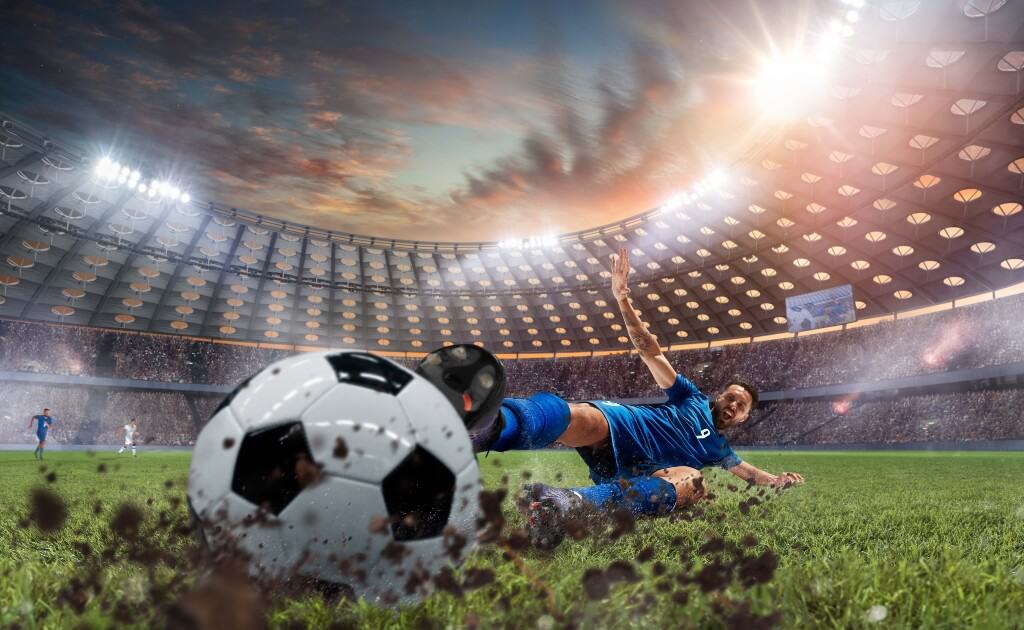Although it may be winter here in the UK, the 2022 World Cup in Qatar is getting fans worldwide in a frenzy about football. With 5 billion viewers estimated to tune into what is expected to be the most-watched tournament in history, there is no surprise if you find yourself reaching for your boots to test out some new skills at your local 5-a-side after catching World Cup fever. However, since football is a high-contact sport, its players are the most prone to injuries.
As a football player or trainer, it is important to familiarise yourself with the treatment options for some of the most common football injuries. In this article, we will break these injuries down and provide tips for managing and avoiding them in the first place.
Most Common Injuries In Football
Due to the nature of the sport, you would expect football-related injuries to affect the legs and lower half of the body, but this is not necessarily the case. The most common injuries include:
- Muscle injuries
- Hamstring and groin strains
- Sprained ankles
- Anterior cruciate ligament (ACL) injuries
- Knee injuries
- Wrist and hand injuries
- Concussions
It is worth noting that you are more likely to become injured during a competitive match than during training sessions.
How To Manage Injuries
We understand that there is nothing more frustrating than having an injury that prevents you from being able to play. That is why we are sharing some effective tips on how to manage and avoid these common injuries.
Muscle Strain
When a tendon between muscles and bones is overstretched, this is likely to cause muscle strain. This is very common in football due to the nature of the game as players can make sudden movements, such as accelerating or tackling. These strains can affect many places but usually affect the back and hamstrings
Also known as pulled muscles, a muscle strain occurs when a muscle or a tendon (the fibrous tissue connecting the muscles to the bones) is overstretched. Usually, muscle strains are the result of sudden acceleration or deceleration.
Muscle strains come in 3 grades, ranging from severity of symptoms. However, if pain persists and strength and movement are limited, there may be a requirement for surgery or deeper inspection. Warming up can go a long way to avoid muscle strains whilst playing football. Stretching allows the muscles to loosen, lending flexibility and protecting muscles from overstretching while active.
Sprained Ankle
Much like a muscle strain, sprained ankles also occur due to overstretching but in this case it’s the ligaments that alleviate the ankle joint that are the cause. Agility on a football pitch is a must, meaning a player can end up making a sudden movement, especially when playing on an uneven surface. As a result, the ankle can roll, causing ligaments to stretch and leading to a sprained ankle.
In addition to warming up and stretching, wearing ankle support and trainers or boots that suit your foot type can help stabilise the ankle and limit unexpected movement, reducing the chance of injury.
Hamstring Strain
Large thigh muscles are a general identifier of the modern-day footballer. This is because these large powerful muscles are relied upon to generate speed, drive acceleration and withstand the physical intensity of a match.
Being a fast-paced game, playing football can require quick changes of pace within an instance. If your hamstrings do not have enough length (from stretching) or strength, they can become overloaded, causing strain.
Like with other injuries, stretching is a must to avoid a hamstring strain. Not to mention, using a round foam roller can relax and massage tight muscles, helping to strengthen the hamstring.
Groin Strain
Adductor (inner thigh muscles) related injuries are likely to result in deep pain in the groin. You are most likely to notice this pain on long runs when the muscle gets tired. On the pitch, you may experience pain when kicking, standing on one leg, or during quick turns. You may even experience pain whilst coughing and sneezing. Generally, groin strains occur when a player puts too much stress on their dominant leg and can vary in severity.
Managing Strains And Sprains
With most strains, it is wise to follow the ‘POLICE’ steps. POLICE, previously known as ‘RICE’ (rest, ice, compress, and elevation). This is an acronym you can use to remind and guide yourself on how to manage your acute soft tissue and musculoskeletal injury
- Protection and Optimal Loading- You should try to avoid complete rest. It is advisable to keep yourself moving as normally as possible within the limits of your pain
- Ice – Applying crushed ice in a towel to the area for 10 minutes a couple of times a day might help reduce pain and swelling
- Compression – Using a compression stocking or bandage around your injured body part can help reduce swelling
- Elevation – Elevating your injured body part can also help to reduce swelling
If you follow this advice after your injury, you will heal in the best possible way and minimise potential complications such as muscle wasting, stiffness in the joint and long-term pain.
Anterior cruciate ligament (ACL) injury
The ACL is a very important ligament that helps to stabilise the knee joint. It is usually injured if your lower leg stays planted, while the upper part of your leg twists or moves. Generally, this occurs when a player lands a jump whilst still in motion or during a tackle.
While a full tear of your ACL would most likely need surgery, a sprain can usually be managed with physiotherapy and rehabilitation.
If you injure your knee, follow the POLICE steps above. If it is still painful and swollen after several days, it is important to seek medical advice. A medical professional can assess how badly you have damaged your ACL and give you advice on the type of treatment you might need.
Tips For Preventing Football-Related Injuries
Strengthening the muscles in your leg will help you avoid injury and ensure your body is well-prepared to withstand the demands of a sport like football.
Warming up and stretching properly can only take a few minutes but can save you from months of pain. It is advisable to do some stretching and jogging to increase blood flow to your muscles prior to playing. This will help prevent a sprain or strain.
You can also protect your body by wearing the right type of clothing and gear. It is worth getting fitted with quality boots, proper sports socks and wearing shin guards too.
Equally, it is crucial to stay hydrated and eat the right foods to fuel your body during exercise and help you recover afterwards. To further improve recovery, it is important to get lots of rest in between training and matches. That way, your body has the time it needs to repair.
At Midland Health, we work with a number of Premier League, La Liga and Championship football clubs, providing professional players with consultations, home visits, physiotherapy, musculoskeletal ultrasounds and more. If you are experiencing a football injury or another sports-related issue, our specialists are on hand to assess, support and treat you as quickly as possible.
You can call us on 0121 769 0999 or alternatively send an email to hello@midlandhealth.co.uk. Our friendly team will book you an appointment with one of our specialists on a date and time that suits you. We will support you in living happier and healthier.

